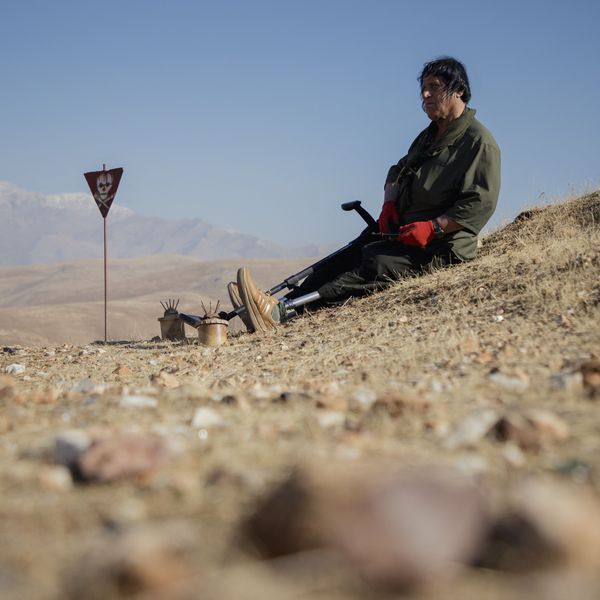
An inflatable nuclear missile balloon stands at the ready before a protest held by the group Global Zero in McPherson Square on April 1, 2016 in Washington, DC.
Land-Based ICBMs: America’s Maginot Line
Instead of updating these missiles in the prairie states, policymakers should create jobs by building a clean energy infrastructure of wind turbines and solar panels.
Here’s a lesson from the past. During the 1930s, France built the Maginot Line in hopes of deterring an anticipated invasion from Nazi Germany. The line ran north from the point where France touches Switzerland but stopped at the Belgian border, where the Belgians objected to its continuation to the English Channel.
But Nazi Germany never intended to invade by way of the Franco-German border. Instead, it did exactly what Imperial Germany did in World War I by cutting into France through Belgium. France fell in six weeks.
Since then, the Maginot Line has been a byword for military stupidity. Regular readers of this column probably know all of this, but what’s interesting now is that America has created its own Maginot Line: the land-based intercontinental ballistic missile (ICBM) system in Montana, Wyoming, and North Dakota, complete with a new generation of missiles—the Sentinels—now under construction.
Several justifications have been offered for the continued operation of this latter-day Maginot Line. Many of our federal officials, both in and out of the armed forces, believe that land-based ICBMs are a necessary part of a triad of land, air, and sea-based weapons which can best assure our safety from a potential enemy attack. They argue that if a potential enemy has several missile systems to contend with, it will have to spread its own forces too thinly to defeat us. Thus any attack on its part will fail.
However, any usefulness which land-based missiles have vanishes when one remembers how vulnerable they are. They’re set in stationary underground silos whose locations are well known. For them to be effective, we would have to fire them at an enemy before his missiles could hit us. The result of this situation is a world on hair-trigger alert, complete with a strong temptation to launch a so-called preemptive nuclear strike which would escalate into a world war.
Another rationale which proponents of land-based ICBMs offer is that even if the missiles are impractical as weapons, they would act as a nuclear sponge. An enemy would have to waste so many missiles attacking our ICBMs that our population, infrastructure, and government centers would be spared while our sea and air missiles would destroy his country entirely. The delusion in this case is that nuclear war is winnable.
Replacing an infrastructure that threatens wholesale death would be a job creating and community-sustaining infrastructure which promotes life.
But the nuclear sponge argument fails to account for both the adjacent and downwind effect of any large-scale nuclear exchange, which would bring forth a nuclear winter deadly enough to kill hundreds of millions, if not billions, of human beings. In fact, each nuclear superstate has enough firepower to wipe out almost all life on Earth six or seven times over. Any single part of their missile systems—air, sea, or land—would be more than enough for the grisly work.
The final assertion which proponents of land-based missile systems offer is that of economic security. Building, maintaining, and updating those missiles creates jobs. Even if the missiles themselves are worthless and provocative, there are entire communities whose well-being depends on keeping these systems up and running. The alternative is economic collapse, given the relative lack of natural wealth on the high plains of Montana, Wyoming, and North Dakota, where they are based.
Forgotten in that claim is that the high prairie is a cornucopia of wind and sunlight, a pair of resources on which to build a clean energy infrastructure of wind turbines and solar panels which would answer the challenge of global warming. Replacing an infrastructure that threatens wholesale death would be a job creating and community-sustaining infrastructure which promotes life. As the National Priorities Project has shown over and over again, the number of jobs so created would double the number created by the Sentinel program.
How to do it? We already know how to build, operate, and maintain wind turbines and solar panels, the materials for which have become less expensive by the year. Build them now, and do it at a pace which keeps people at work while we put our own worthless and dangerous contemporary Maginot Line in the past, alongside the long-failed, historical Maginot Line. Whatever remains of them can serve us as both a monument to and a caution against our own sometime stupidity.
We need not be so stupid.
An Urgent Message From Our Co-Founder
Dear Common Dreams reader, The U.S. is on a fast track to authoritarianism like nothing I've ever seen. Meanwhile, corporate news outlets are utterly capitulating to Trump, twisting their coverage to avoid drawing his ire while lining up to stuff cash in his pockets. That's why I believe that Common Dreams is doing the best and most consequential reporting that we've ever done. Our small but mighty team is a progressive reporting powerhouse, covering the news every day that the corporate media never will. Our mission has always been simple: To inform. To inspire. And to ignite change for the common good. Now here's the key piece that I want all our readers to understand: None of this would be possible without your financial support. That's not just some fundraising cliche. It's the absolute and literal truth. We don't accept corporate advertising and never will. We don't have a paywall because we don't think people should be blocked from critical news based on their ability to pay. Everything we do is funded by the donations of readers like you. Will you donate now to help power the nonprofit, independent reporting of Common Dreams? Thank you for being a vital member of our community. Together, we can keep independent journalism alive when it’s needed most. - Craig Brown, Co-founder |
Here’s a lesson from the past. During the 1930s, France built the Maginot Line in hopes of deterring an anticipated invasion from Nazi Germany. The line ran north from the point where France touches Switzerland but stopped at the Belgian border, where the Belgians objected to its continuation to the English Channel.
But Nazi Germany never intended to invade by way of the Franco-German border. Instead, it did exactly what Imperial Germany did in World War I by cutting into France through Belgium. France fell in six weeks.
Since then, the Maginot Line has been a byword for military stupidity. Regular readers of this column probably know all of this, but what’s interesting now is that America has created its own Maginot Line: the land-based intercontinental ballistic missile (ICBM) system in Montana, Wyoming, and North Dakota, complete with a new generation of missiles—the Sentinels—now under construction.
Several justifications have been offered for the continued operation of this latter-day Maginot Line. Many of our federal officials, both in and out of the armed forces, believe that land-based ICBMs are a necessary part of a triad of land, air, and sea-based weapons which can best assure our safety from a potential enemy attack. They argue that if a potential enemy has several missile systems to contend with, it will have to spread its own forces too thinly to defeat us. Thus any attack on its part will fail.
However, any usefulness which land-based missiles have vanishes when one remembers how vulnerable they are. They’re set in stationary underground silos whose locations are well known. For them to be effective, we would have to fire them at an enemy before his missiles could hit us. The result of this situation is a world on hair-trigger alert, complete with a strong temptation to launch a so-called preemptive nuclear strike which would escalate into a world war.
Another rationale which proponents of land-based ICBMs offer is that even if the missiles are impractical as weapons, they would act as a nuclear sponge. An enemy would have to waste so many missiles attacking our ICBMs that our population, infrastructure, and government centers would be spared while our sea and air missiles would destroy his country entirely. The delusion in this case is that nuclear war is winnable.
Replacing an infrastructure that threatens wholesale death would be a job creating and community-sustaining infrastructure which promotes life.
But the nuclear sponge argument fails to account for both the adjacent and downwind effect of any large-scale nuclear exchange, which would bring forth a nuclear winter deadly enough to kill hundreds of millions, if not billions, of human beings. In fact, each nuclear superstate has enough firepower to wipe out almost all life on Earth six or seven times over. Any single part of their missile systems—air, sea, or land—would be more than enough for the grisly work.
The final assertion which proponents of land-based missile systems offer is that of economic security. Building, maintaining, and updating those missiles creates jobs. Even if the missiles themselves are worthless and provocative, there are entire communities whose well-being depends on keeping these systems up and running. The alternative is economic collapse, given the relative lack of natural wealth on the high plains of Montana, Wyoming, and North Dakota, where they are based.
Forgotten in that claim is that the high prairie is a cornucopia of wind and sunlight, a pair of resources on which to build a clean energy infrastructure of wind turbines and solar panels which would answer the challenge of global warming. Replacing an infrastructure that threatens wholesale death would be a job creating and community-sustaining infrastructure which promotes life. As the National Priorities Project has shown over and over again, the number of jobs so created would double the number created by the Sentinel program.
How to do it? We already know how to build, operate, and maintain wind turbines and solar panels, the materials for which have become less expensive by the year. Build them now, and do it at a pace which keeps people at work while we put our own worthless and dangerous contemporary Maginot Line in the past, alongside the long-failed, historical Maginot Line. Whatever remains of them can serve us as both a monument to and a caution against our own sometime stupidity.
We need not be so stupid.
Here’s a lesson from the past. During the 1930s, France built the Maginot Line in hopes of deterring an anticipated invasion from Nazi Germany. The line ran north from the point where France touches Switzerland but stopped at the Belgian border, where the Belgians objected to its continuation to the English Channel.
But Nazi Germany never intended to invade by way of the Franco-German border. Instead, it did exactly what Imperial Germany did in World War I by cutting into France through Belgium. France fell in six weeks.
Since then, the Maginot Line has been a byword for military stupidity. Regular readers of this column probably know all of this, but what’s interesting now is that America has created its own Maginot Line: the land-based intercontinental ballistic missile (ICBM) system in Montana, Wyoming, and North Dakota, complete with a new generation of missiles—the Sentinels—now under construction.
Several justifications have been offered for the continued operation of this latter-day Maginot Line. Many of our federal officials, both in and out of the armed forces, believe that land-based ICBMs are a necessary part of a triad of land, air, and sea-based weapons which can best assure our safety from a potential enemy attack. They argue that if a potential enemy has several missile systems to contend with, it will have to spread its own forces too thinly to defeat us. Thus any attack on its part will fail.
However, any usefulness which land-based missiles have vanishes when one remembers how vulnerable they are. They’re set in stationary underground silos whose locations are well known. For them to be effective, we would have to fire them at an enemy before his missiles could hit us. The result of this situation is a world on hair-trigger alert, complete with a strong temptation to launch a so-called preemptive nuclear strike which would escalate into a world war.
Another rationale which proponents of land-based ICBMs offer is that even if the missiles are impractical as weapons, they would act as a nuclear sponge. An enemy would have to waste so many missiles attacking our ICBMs that our population, infrastructure, and government centers would be spared while our sea and air missiles would destroy his country entirely. The delusion in this case is that nuclear war is winnable.
Replacing an infrastructure that threatens wholesale death would be a job creating and community-sustaining infrastructure which promotes life.
But the nuclear sponge argument fails to account for both the adjacent and downwind effect of any large-scale nuclear exchange, which would bring forth a nuclear winter deadly enough to kill hundreds of millions, if not billions, of human beings. In fact, each nuclear superstate has enough firepower to wipe out almost all life on Earth six or seven times over. Any single part of their missile systems—air, sea, or land—would be more than enough for the grisly work.
The final assertion which proponents of land-based missile systems offer is that of economic security. Building, maintaining, and updating those missiles creates jobs. Even if the missiles themselves are worthless and provocative, there are entire communities whose well-being depends on keeping these systems up and running. The alternative is economic collapse, given the relative lack of natural wealth on the high plains of Montana, Wyoming, and North Dakota, where they are based.
Forgotten in that claim is that the high prairie is a cornucopia of wind and sunlight, a pair of resources on which to build a clean energy infrastructure of wind turbines and solar panels which would answer the challenge of global warming. Replacing an infrastructure that threatens wholesale death would be a job creating and community-sustaining infrastructure which promotes life. As the National Priorities Project has shown over and over again, the number of jobs so created would double the number created by the Sentinel program.
How to do it? We already know how to build, operate, and maintain wind turbines and solar panels, the materials for which have become less expensive by the year. Build them now, and do it at a pace which keeps people at work while we put our own worthless and dangerous contemporary Maginot Line in the past, alongside the long-failed, historical Maginot Line. Whatever remains of them can serve us as both a monument to and a caution against our own sometime stupidity.
We need not be so stupid.

